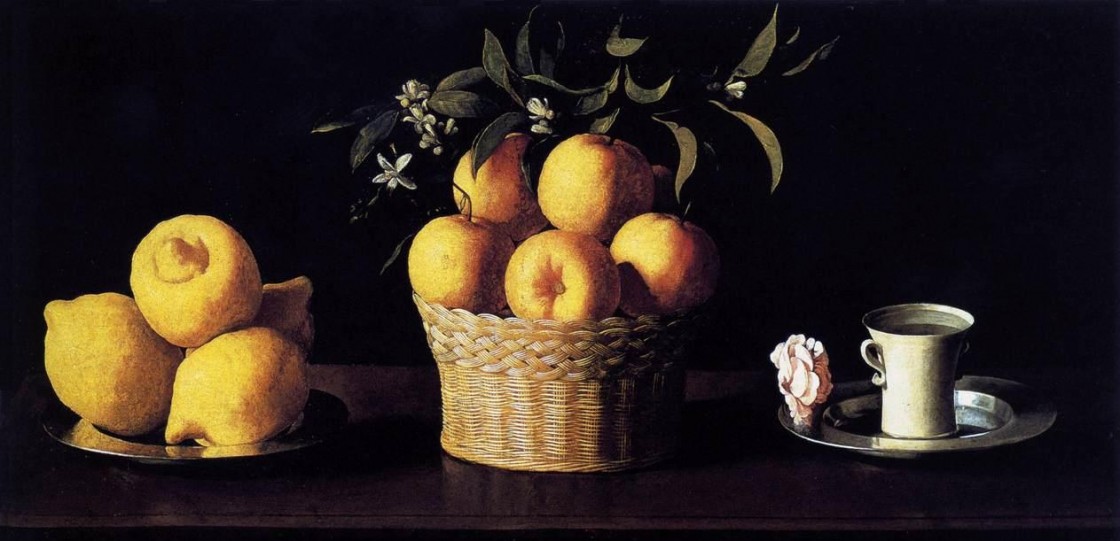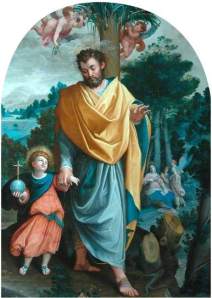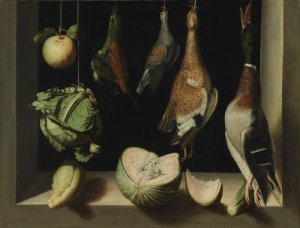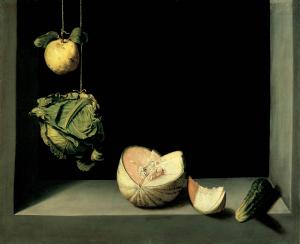Juán Sanchez Cotán (1560- 1627) is known for being one of the first still life painters in Europe. Cotán was a contemporary of El Greco [1] who met with success as a painter in Toledo. Though he had his own workshop where he also painted devotional pieces,
he is best known for his still-lifes. These still-lifes were defined by highly ordered figures [2] and always consisted of a window which framed the items that he painted [3] . The window which he consistently depicts in his still life would have been a functioning part of a Spanish house. This window was known as a canarero [4] and would have been a cool place where vegetables and fowl could be kept before it was to be prepared and cooked so they would not spoil. [1] Cotán utilized this window ledge like a stage creating a deep space which lent itself to the illusion that the fruits and vegetable he rendered were actually enter the viewer’s space. In some of his images he used a string to hang the fruits, vegetables and fowl. This hanging of food would have been a common practice during the time as it protected the food from bruising and from pests. [3] For Cotán this string was a useful visual device, by cutting off the top of the window and not allowing the viewer to see from where the item is hung he creates an interesting perspective which adds to the illusion that these foods are actually popping out of the frame. [2] However this 3-D effect that Cotán creates would not be possible if it were not for his use of a dark, almost completely black, background. This background created a sense of depth, pushing backwards into the recesses of the window while effectively pushing the items themselves forward to the very front of the canvas [3]
At the age of 43 Cotán would leave his workshop in Toledo to seek a more spiritual life in Granada, where he joined the carthusian order of monks. Upon resigning from secular life to becoming a monk an inventory of his positions was take, in this inventory 12 still-lifes were recorded. At least two of which are accounted for today. [1]
In his painting Still life with Quince Cabbage, Melon and Cucumber Cotán utilizes what is called the hyperbolic curve, which is a geometric shape that follows a particular mathematical formula. He utilized this hyperbolic curve in many of his still lifes, sometimes leaving the space blank and other times filling it with game , fruit or vegetables. In Quince Cabbage, Melon and Cucumber he is said to have created a pure hyperbolic curve. This pushes the meaning of the painting past that of just food, and into the realm of a thought provoking piece on geometry and divine perfection. [4]
Many try to prescribe spiritual and symbolic value to the items in Cotán’s paintings, though there is little written evidence for it. His induction into monastic life as a Carthusian lay brother only further fuels this idea. [5] Regardless of his symbolic intentions Cotán’s beautifully rendered study of the natural world helped to elevate the status of still life in 17th century Spain and made it an art form which was acceptable for even the most highly regarded artists of the 17th century to pursue. [3]
1. William B. Jordan. “Sánchez Cotán, Juan.” Grove Art Online. Oxford Art Online. Oxford University Press, accessed May 20, 2014,http://www.oxfordartonline.com.libproxy.cc.stonybrook.edu/subscriber/article/grove/art/T075605.
2. Peter Cherry, “Sánchez Cotán at the Prado. Madrid” The Burlington Magazine, Vol. 135, No. 1079 (Feb., 1993), pp. 164-166, accessed May 19th, 2014. JSTOR http://www.jstor.org/stable/885474
3. “Spanish Painting from El Greco to Picasso: Time, Truth, and History Bodegones” The Solomon R. Guggenheim Foundation (SRGF), accessed May 19, 2014 http://www.chicagomanualofstyle.org/tools_citationguide.html
4. Langdon, Anthony. “Sánchez Cotán, Juan.” The Oxford Companion to Western Art. Oxford Art Online. Oxford University Press, accessed May 20, 2014,http://www.oxfordartonline.com.libproxy.cc.stonybrook.edu/subscriber/article/opr/t118/e2337
5. Taggard, Mindy Nancarrow review of Spanish Still Life from Velazquez to Goya, by William B. Jordan; Peter Cherry, The Sixteenth Century Journal, Accessed May 19, 2014 JSTOR http://www.jstor.org/stable/2544079











